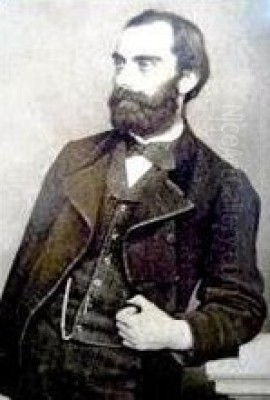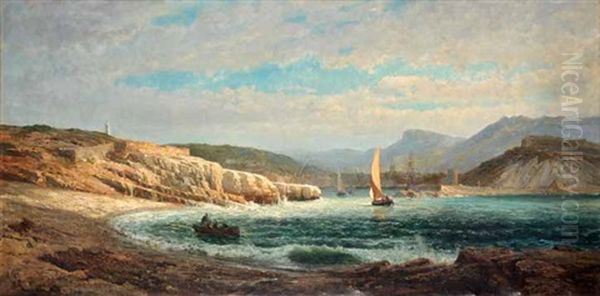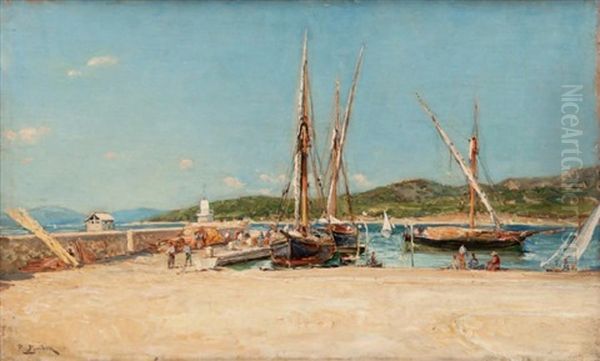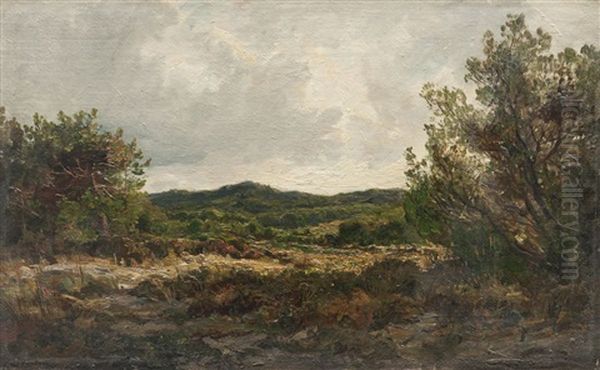
Luc Raphaël Ponson, often known simply as Raphaël Ponson, stands as a significant figure in 19th-century French art, particularly renowned for his evocative landscapes of the Mediterranean coast. Born in the vibrant port city of Marseille in 1835 and passing away in his native city in 1904, Ponson's life and career were inextricably linked to the sun-drenched vistas and azure waters of Provence. His work, predominantly executed in oil on canvas, captures the unique interplay of light, color, and atmosphere that defines this iconic region of France.
Early Life and Artistic Formation
Raphaël Ponson's artistic journey began in Marseille, a city with a burgeoning artistic scene. He was a student at the École des Beaux-Arts in Marseille, where he studied under Émile Loubon (1809-1863), a pivotal figure in Provençal painting and the director of the school. Loubon was instrumental in fostering a regional school of landscape painting that emphasized direct observation of nature and a departure from purely academic traditions. This early training instilled in Ponson a deep appreciation for the local scenery and the nuances of its light.
Seeking to further refine his skills, Ponson, like many aspiring artists of his time, traveled to Paris. There, he immersed himself in the study of the Old Masters at the Louvre, absorbing lessons in composition, technique, and artistic expression. This period in Paris broadened his artistic horizons, exposing him to the diverse currents of French art, including the burgeoning Realist movement championed by artists like Gustave Courbet (1819-1877) and the Barbizon School painters such as Jean-Baptiste-Camille Corot (1796-1875), Théodore Rousseau (1812-1867), and Charles-François Daubigny (1817-1878), who were revolutionizing landscape painting by advocating for plein air (outdoor) work and a more naturalistic depiction of the countryside.
Despite his Parisian studies, Ponson's heart remained in Provence. He eventually returned to Marseille, where he established his career and became a celebrated painter of its coastal environments. His deep connection to his native region would become the defining characteristic of his oeuvre.
Artistic Style and Thematic Focus

Ponson's artistic style is characterized by a profound sensitivity to the effects of light and atmosphere, particularly the brilliant Mediterranean sun. While his work demonstrates a strong foundation in observational realism, he often imbued his scenes with a poetic and decorative quality. His paintings are noted for their rich, luminous color palettes and his ability to capture the shimmering reflections on water, the rugged textures of coastal cliffs, and the vibrant life of bustling harbors.
His primary thematic focus was the diverse landscapes of the Provençal coast. He painted numerous views of Marseille's Old Port, the dramatic Calanques (rocky inlets), the beaches near Cassis, and the picturesque shores of Saint-Tropez and Sainte-Maxime. These were not mere topographical records; Ponson sought to convey the emotional resonance of these places, the feeling of the sea breeze, the warmth of the sun, and the timeless beauty of the Mediterranean world. His signature, "R. Ponson," is typically found on the lower left of his canvases.
While contemporary with the Impressionist movement, which saw artists like Claude Monet (1840-1926), Camille Pissarro (1830-1903), and Alfred Sisley (1839-1899) revolutionize the depiction of light and color, Ponson's style, though light-filled, retained a greater emphasis on structure and a more polished finish than many of his Impressionist peers. He was more aligned with a tradition of Provençal landscape painting that, while embracing naturalism, also valued a certain lyrical and decorative sensibility. His approach often favored a harmonious composition and a careful rendering of details, even as he masterfully conveyed the transient effects of light.
Representative Works and Exhibitions
Throughout his career, Raphaël Ponson produced a significant body of work, many of which have become iconic representations of the French Riviera. Among his most notable paintings are:
Le port de Cassis (The Port of Cassis): This work, and others depicting Cassis, showcases his ability to capture the charm of Mediterranean fishing villages, with their colorful boats, quaint buildings, and the dramatic backdrop of cliffs like Cap Canaille.
Maison des Glayes à Saint Tropez (House of Glayes in Saint Tropez): Before Saint-Tropez became the playground of the international elite, it was a picturesque fishing village that attracted artists. Ponson's depictions highlight its authentic charm.
Le Chemin de la Corniche, Marseille (The Corniche Road, Marseille): This subject allowed Ponson to explore the interplay between the urbanized coastline and the expansive sea, often under the brilliant Provençal sun.

Le môle de Sainte Maxime (The Pier of Sainte Maxime): Such scenes of harbors and piers were a recurring motif, allowing him to study reflections on water and the activity of coastal life.
Mer de Mistral à Montredon (Mistral Sea at Montredon): The Mistral wind is a powerful force in Provence, and Ponson captured its dramatic impact on the sea, showcasing a more dynamic and rugged aspect of the Mediterranean.
Le Château d'If (The Château d'If): This iconic island fortress off the coast of Marseille, famous from Alexandre Dumas's The Count of Monte Cristo, was a subject Ponson depicted. He exhibited a version of this at the prestigious Paris Salon in 1861, marking an important step in his public recognition.
Paysage sur l'île de Porquerolles (Landscape on Porquerolles Island): The Hyères Islands, including Porquerolles, offered pristine natural beauty that Ponson translated onto canvas with his characteristic sensitivity to light and color.
Ponson was not only a painter of easel works but also undertook significant decorative commissions. He created large-scale mural paintings for important public buildings in Marseille, including the Musée de l'Histoire Naturelle (Natural History Museum) housed within the Palais Longchamp, and for the museum itself (Musée des Beaux-Arts de Marseille, also in Palais Longchamp). These murals often depicted lush, idealized landscapes and allegorical scenes, showcasing his versatility and his ability to work on a grand scale, contributing to the civic pride and artistic embellishment of his native city.
Ponson and His Contemporaries in Provence
Raphaël Ponson was part of a vibrant artistic community in Provence. He is often associated with the "Provençal School" of painters who, following the lead of Émile Loubon, dedicated themselves to capturing the unique character of their region. Among his notable contemporaries who also focused on the landscapes and seascapes of the South of France were:
Jean-Baptiste Olive (1848-1936): Another Marseille-born artist, Olive was renowned for his luminous depictions of the Provençal coast, particularly the Calanques and the Old Port of Marseille. His style, like Ponson's, emphasized light and atmosphere.
Joseph Garibaldi (1863-1941): Also from Marseille, Garibaldi specialized in views of the Old Port and coastal scenes, often with a meticulous attention to detail and a bright palette.

Paul Guigou (1834-1871): Though his career was tragically short, Guigou, born in Vaucluse, was a leading figure in Provençal landscape painting, known for his luminous and precisely rendered views of the Durance valley and the arid landscapes of Haute-Provence. His clarity of light and form was highly influential.
Marius Guindon (1831-1918): A contemporary of Ponson in Marseille, Guindon also painted local landscapes and genre scenes, contributing to the regional artistic identity.
Alfred Casile (1848-1909): Born in Marseille, Casile painted landscapes and marine scenes of Provence with a sensitivity to light that sometimes approached Impressionism.
Félix Ziem (1821-1911): While not exclusively a Provençal painter, Ziem spent considerable time in Martigues, near Marseille, and his vibrant, atmospheric depictions of Venetian and Mediterranean scenes, characterized by rich color and dramatic light, were widely admired and shared some affinities with the Provençal painters' love for luminous effects.
Adolphe Monticelli (1824-1886): A highly individualistic Marseille painter, Monticelli was known for his richly impastoed surfaces and fantastical, romantic scenes, often set in lush landscapes. While stylistically different from Ponson, he was a key figure in the Marseille art scene.
The artistic environment in Provence during the latter half of the 19th century was dynamic. While Paris remained the undisputed center of the art world, regional schools like the one in Provence were gaining prominence, celebrating local identity and landscape. Later, artists like Paul Cézanne (1839-1906) from Aix-en-Provence, and visiting artists such as Vincent van Gogh (1853-1890) in Arles, and Paul Signac (1863-1935) who worked extensively in Saint-Tropez, would further elevate the South of France as a site of major artistic innovation, building on the foundations laid by painters like Ponson and his generation.
Public Commissions and Decorative Art
Ponson's contributions extended beyond easel painting into the realm of large-scale decorative works. His murals for the Musée de l'Histoire Naturelle de Marseille and the Palais Longchamp are significant examples of public art from this period. These commissions reflect a broader 19th-century trend of embellishing civic buildings with art that celebrated local history, nature, or industry.

For the Natural History Museum, Ponson created panoramic landscapes and depictions of flora and fauna, designed to complement the museum's collections and create an immersive environment for visitors. These works required not only artistic skill but also an understanding of natural history and the ability to integrate art within an architectural space. His decorative panels often featured idealized visions of nature, characterized by lush vegetation, serene waters, and a harmonious balance of elements. This aspect of his work highlights his versatility and his engagement with the public role of art. The pursuit of decorative beauty, a hallmark of his style, found a grand expression in these commissions.
Legacy and Market Reception
Raphaël Ponson achieved considerable success during his lifetime, recognized for his skill in capturing the essence of the Mediterranean landscape. His works were regularly exhibited, and he received official commissions, attesting to his standing in the art world of his time.
In the contemporary art market, Ponson's paintings continue to be sought after by collectors, particularly those specializing in 19th-century French landscape painting or art of the Provençal region. Auction records show a consistent demand for his work, with prices varying based on size, subject matter, condition, and provenance. Major works, such as large, well-executed views of iconic locations like Cassis or Marseille, can command significant sums, sometimes reaching tens of thousands of euros. For instance, his Le port de Cassis has been estimated in the range of €10,000 to €12,000, while Le môle de Sainte Maxime saw estimates between €12,000 and €15,000. Smaller studies or less prominent subjects might fetch prices from several hundred to a few thousand euros, such as Paysage sur l'île de Porquerolles estimated at €800 to €1,000.
Academically, Ponson is recognized as an important figure within the Provençal school of painting. His work is valued for its technical skill, its lyrical depiction of the Mediterranean coast, and its contribution to the tradition of French landscape art. Art historians often place his work in the context of late 19th-century realism, with an emphasis on the particular qualities of light and color that define Provençal painting. His painting Le Chemin de la Corniche, Marseille has been cited as a classic example of his style and is featured in discussions of art from this period. His murals are also acknowledged as significant contributions to the decorative arts in Marseille.
Conclusion
Raphaël Ponson (1835-1904) carved a distinct niche for himself in the annals of French art as a dedicated and sensitive chronicler of the Provençal coast. From the bustling harbors of Marseille to the tranquil coves of Cassis and the sun-drenched shores of Saint-Tropez, his canvases radiate with the unique light and vibrant colors of the Mediterranean. Influenced by his training under Émile Loubon and his studies in Paris, Ponson developed a style that blended realistic observation with a poetic and decorative sensibility. His prolific output, including easel paintings and significant public murals, cemented his reputation as a leading figure of the Provençal school. Today, his works continue to be admired for their beauty, their technical mastery, and their evocative portrayal of a beloved region, ensuring Raphaël Ponson's enduring legacy as a master of Mediterranean light and landscape.